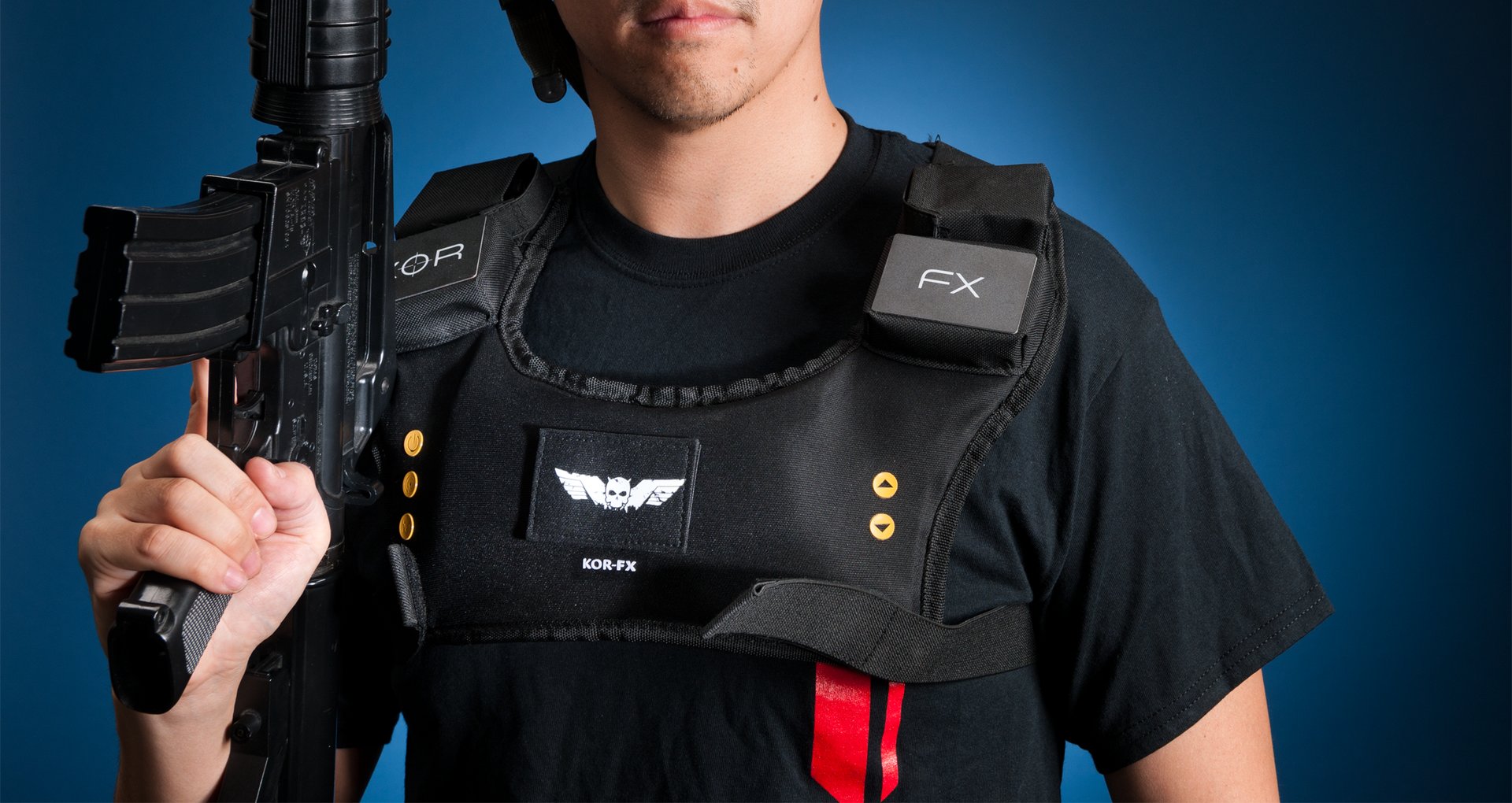Our Verdict
Fun, but really only for hardcore gamers.
PC Gamer's got your back
Rumble pack: Makes firefights more intense; relatively easy setup.
DualShock: Acoustics-to-haptics system is wonky; no USB headset support.
It’s a Rumble Pak… for your body
In an attempt to make gaming more immersive, Nintendo introduced the Rumble Pak for the N64 way back in 1997. Kickstarter-funded company Immerz hopes to up the ante, and the haptic feedback, with its Kor-FX “immersive gaming vest.”
Shahriar Afshar, a physicist with a background in neuroscience, came up with the concept of embedding two vibrating transducers into the vest and using what he calls 4DFX technology to convert acoustic signals into haptic feedback. The two transducers are located along the chest region of the vest. There’s one each for the left and right sides of your body, and they’re spaced roughly ear-distance apart. The theory here is that, when you talk, most of the vibration comes from within your chest. Thus, the internal vibrations here are what the vest is trying to emulate.
The vest itself is relatively comfy, though with any gaming peripheral that you have to wear, it’s a slight hassle to put it on. You’ll also look extremely dorky wearing it. Luckily, it fits a wide variety of body types with its two Velcro straps that you can adjust to your anatomical needs. We really liked that the vest is wireless. We didn’t like that the four AA batteries needed to power the vest weren’t included, however. The vest syncs up to your PC via a square-ish dongle that measures roughly 3x2 inches. This dongle blasts out an RF signal to the vest and hooks up to the computer via a Mini-USB cable. The dongle can also be powered by four AA batteries, if you wanted to go down the wireless route there.
Set up is relatively simple. Once you’ve got the dongle powered, you simply plug in a 3.5mm auxiliary cable (included) from the dongle into your PC’s audio jack. From here, you can plug your analog headset into the dongle. And that’s largely it. There’s no software or driver for you to download. That doesn’t mean you can’t customize the experience, however. The vest has several physical buttons on it. When wearing it, you’ll find two buttons on the left side of the vest that allow you to adjust the intensity of the vibrations. The right side of the vest has buttons to turn on the vest, pair the vest with the dongle, and different sensitivity presets. These presets determine how sensitive the vest is at converting audio to vibrations. While there are three different presets, Immerz admits that the differences are extremely subtle. We couldn’t really feel any difference between them.

In regard to how it feels overall, the closest analogy we can use is that of the sensation you get when you’re sitting in a movie theater with some kick-ass speakers, and a loud explosion goes off. The thunderous vibrations make you feel somewhat connected to the experience. Explosions and firing a machine gun in an intense first-person shooter with the vest feels good for the most part, and contributes to the sensation that you’re in the thick of the action. Our favorite moment thus far has been trying to defuse a bomb in Counter Strike: Global Offense, only to have the bomb explode. It gives the game a slight higher sense of intensity, and we suspect some people will really get a kick out of it.
That’s not to say that the experience is perfect. Because the 4DFX system simply converts audio to vibrations, you’ll sometimes feel vibrations when you shouldn’t. Music, footstep noises, and, to a lesser extent, dialogue can trigger unwanted haptic feedback, for instance. You can mitigate this somewhat by disabling music in games that allow for it. Ideally, there would be different presets tailored toward specific games, and Immerz tells us it’s working on that. The jury is still out on how well that will work, however. The two transducers are also a bit limiting. For instance, getting shot in the back in an FPS will trigger vibrations on the front of the vest. We would have also appreciated it if you could crank up the vibrations up a bit, you know, for the adrenaline junkies. Another gripe we have with the device is that, at the moment, the dongle only takes in analog headsets. Immerz says it’s working on an optical line in, but the company has no plans to incorporate USB headsets, because of the challenges those pose with their independent sound cards. While understandable, it’s kind of a shame, considering most wireless headsets use USB. Finally, Immerz says that there are interference possibilities with home Wi-Fi signals, but we didn’t experience any of that on our end, through your mileage with it may vary.
At the end of the day, do you really need the Kor-FX vest? No. Does it make game experiences more immersive? Sure. It can make firefights in first-person shooters more intense. It can also make you jump out of your seat in scary games a little more, too. Where we see it making the biggest impact, however, is with VR; here, it could add a sense of tactility to what has otherwise been non-tactile world. But due to its imperfections, we can only really recommend the vest to the hardest of the hardcore.
Fun, but really only for hardcore gamers.



